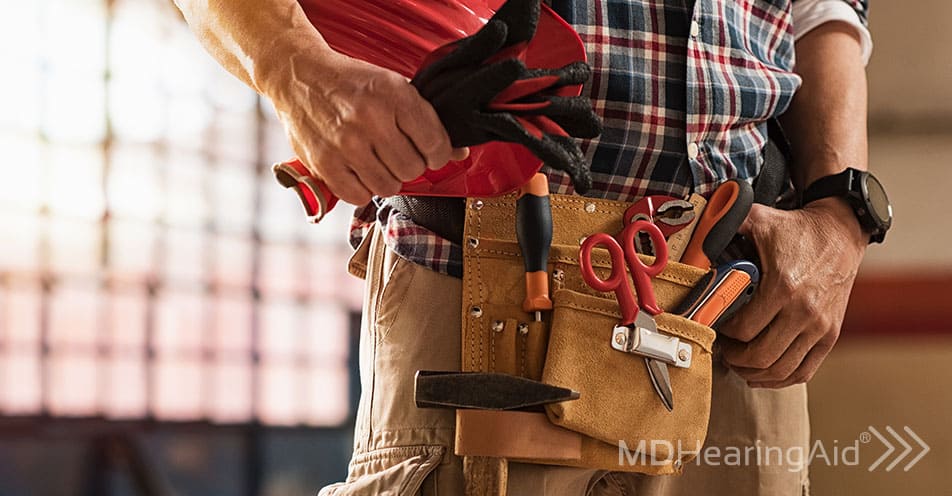Hearing aids can make a huge difference for your quality of life. But like with any other piece of technology, it needs proper maintenance and care. When hearing aid problems arise, often they can be simple enough that you can troubleshoot and solve them yourself. At MDHearingAid, we want you to have the best experience possible with your hearing aids. We’ve compiled this troubleshooting guide to help you solve the most common hearing aid problems.
Problem #1: No sound
You’ve put the hearing aid in your ear and no sound is amplified. There are a few possible causes.
- If the hearing aid is manually turned on and off, you might have left it off or hit the switch as you were putting it on. In this case, turn it on.
- If the device is on, check the volume next. Make sure the volume is set to your preferred setting and that it didn’t accidentally slip to a lower setting.
- Once you are certain the device is on and the volume is up, if there is still no sound, check the battery. If the battery door won’t close properly, the battery might be upside-down. Otherwise, the battery may be depleted and, in this case, you need to change the battery.
- If a fresh battery doesn’t work, check the receiver tube. The tube may be blocked, in which case you need to clean the tube.
- If cleaning the tube does not solve the issue, check the microphone. There may be wax or dirt blocking it. If so, clean it and try the hearing aid again.
Problem #2: The sound isn’t loud enough or is distorted
If you put the hearing aid on and find the hearing aids aren’t loud enough, regardless of the volume, take these steps to try to find a solution:
- Check to see that your hearing aid is set to the right program and volume. If it was accidentally set to the wrong one, set it to the right program.
- Dust or lint may have accumulated in the controls. Switch/rotate the controls and reset them to your preferences to clear any debris.
- If it isn’t the program or a control issue, check to see if there is wax, dirt, or debris blocking the microphone, tube, or earpiece. If you see any, clean these components appropriately.
- Check the battery to see if the battery or the contacts are corroded or damaged. If the battery is corroded or drained, replace it.
- There may be moisture in the system. Use a dehumidifier overnight or use a UV-Clean & Dry Box to remove the unwanted moisture and try it again in the morning.
- If the above doesn’t work, you may need to have your hearing rechecked as your hearing needs may have changed.
Problem #3: There’s a whistling or feedback sound
You put your hearing aid on and there’s a whistling or whining noise coming through. In this case, do the following to troubleshoot your hearing aid:
- Remove the hearing aid and reinsert it into your ear. It may have been misaligned or otherwise improperly placed. Make sure you aren’t turning your head before the hearing aid is secured, or it might contribute to the problem.
- The earpiece might be improperly fitting into your ear. Try replacing it with a closed tip or dome or a different size.
- If this doesn’t fix the issue, turn the volume down. It may be a result of too much sound trying to get through.
- Check for cracks in the tubing or the earhook and replace them if necessary.
- If the problem persists, you may have a blockage of earwax in your ear canal. In this case, you would need to have your ears cleaned thoroughly by a professional.
Problem #4: Sound cuts out or is inconsistent
You use your hearing aid and it seems to cut out or the volume fluctuates. Try the following to troubleshoot this common issue:
- First, check the microphone, tube, or earpiece. There may be wax or dirt interrupting the sound. Clean it and try the hearing aid again.
- Switch the controls a bit and reset to your preferences. There may have been dust or lint that collected in them.
- The hearing aid battery might be low. Check the voltage on it and replace the battery if that’s the case. This should fix the problem.
If you still face hearing aid problems…
If you’ve troubleshooted these common hearing aid problems and are still having difficulty, now’s the time to talk to your hearing aid provider or hearing healthcare professional to have it fixed. See if your hearing aid is still under warranty.
If you’re ready to replace your old broken hearing aid, our hearing aids can include the MDShield™ Protection Plan, which provides 100% coverage against any accidental damage (water damage, pet damage, battery corrosion, etc.) in addition to defects and malfunctions beyond the 90-day warranty period. We’ll even send you a brand new hearing aid at no extra charge if it cannot be repaired by us (note: loss, theft, and unauthorized repairs are not covered).
If your hearing aid problems can’t be fixed by your audiologist, it might be time to upgrade.
TAKE OUR HEARING AID QUIZ
